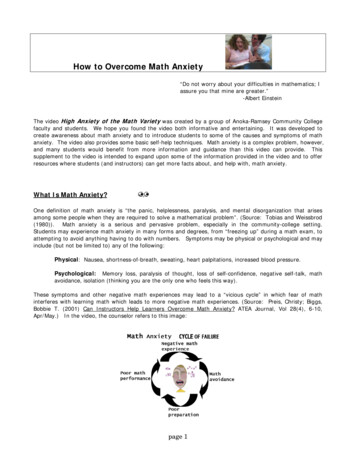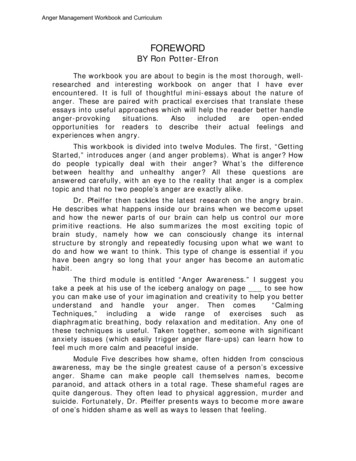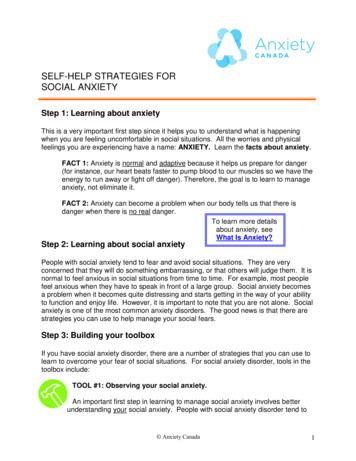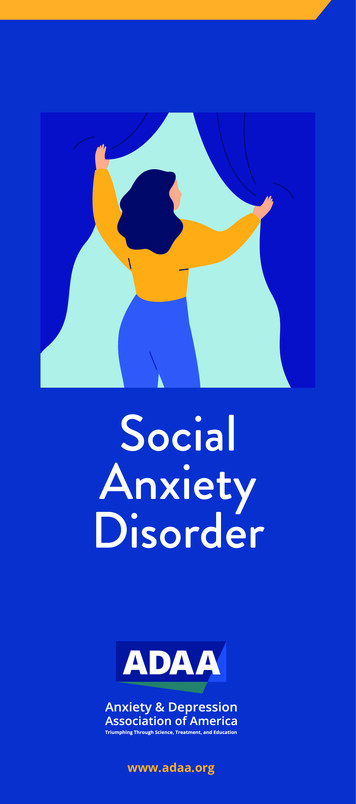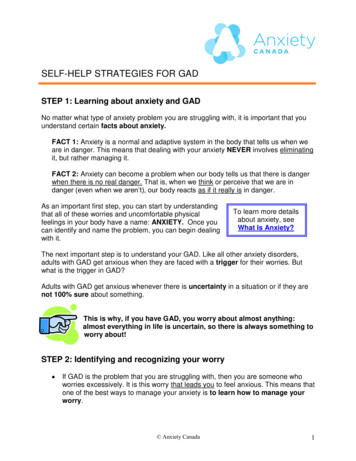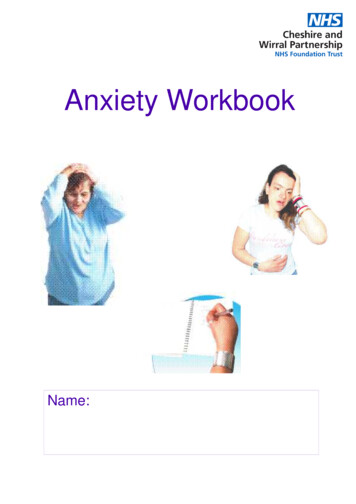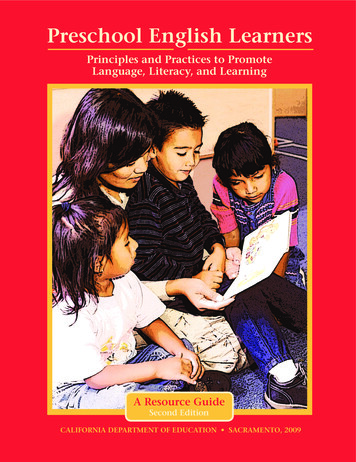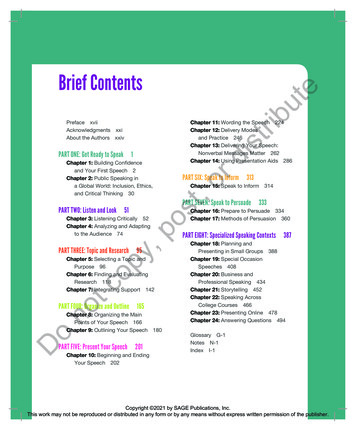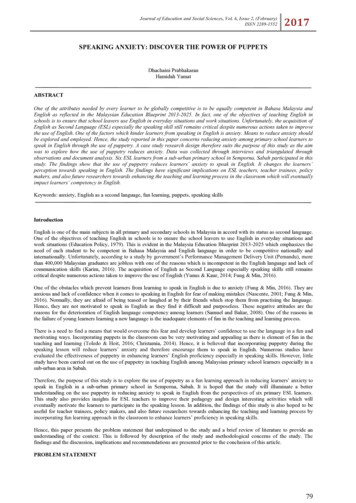
Transcription
Journal of Education and Social Sciences, Vol. 6, Issue 2, (February)ISSN 2289-15522017SPEAKING ANXIETY: DISCOVER THE POWER OF PUPPETSDhachaini PrabhakaranHamidah YamatABSTRACTOne of the attributes needed by every learner to be globally competitive is to be equally competent in Bahasa Malaysia andEnglish as reflected in the Malaysian Education Blueprint 2013-2025. In fact, one of the objectives of teaching English inschools is to ensure that school leavers use English in everyday situations and work situations. Unfortunately, the acquisition ofEnglish as Second Language (ESL) especially the speaking skill still remains critical despite numerous actions taken to improvethe use of English. One of the factors which hinder learners from speaking in English is anxiety. Means to reduce anxiety shouldbe explored and employed. Hence, the study reported in this paper concerns reducing anxiety among primary school learners tospeak in English through the use of puppetry. A case study research design therefore suits the purpose of this study as the aimwas to explore how the use of puppetry reduces anxiety. Data was collected through interviews and triangulated throughobservations and document analysis. Six ESL learners from a sub-urban primary school in Semporna, Sabah participated in thisstudy. The findings show that the use of puppetry reduces learners’ anxiety to speak in English. It changes the learners’perception towards speaking in English. The findings have significant implications on ESL teachers, teacher trainees, policymakers, and also future researchers towards enhancing the teaching and learning process in the classroom which will eventuallyimpact learners’ competency in English.Keywords: anxiety, English as a second language, fun learning, puppets, speaking skillsIntroductionEnglish is one of the main subjects in all primary and secondary schools in Malaysia in accord with its status as second language.One of the objectives of teaching English in schools is to ensure the school leavers to use English in everyday situations andwork situations (Education Policy, 1979). This is evident in the Malaysia Education Blueprint 2013-2025 which emphasizes theneed of each student to be competent in Bahasa Malaysia and English language in order to be competitive nationally andinternationally. Unfortunately, according to a study by government’s Performance Management Delivery Unit (Pemandu), morethan 400,000 Malaysian graduates are jobless with one of the reasons which is incompetent in the English language and lack ofcommunication skills (Karim, 2016). The acquisition of English as Second Language especially speaking skills still remainscritical despite numerous actions taken to improve the use of English (Yunus & Kaur, 2014; Fung & Min, 2016).One of the obstacles which prevent learners from learning to speak in English is due to anxiety (Fung & Min, 2016). They areanxious and lack of confidence when it comes to speaking in English for fear of making mistakes (Nascente, 2001; Fung & Min,2016). Normally, they are afraid of being teased or laughed at by their friends which stop them from practising the language.Hence, they are not motivated to speak in English as they find it difficult and purposeless. These negative attitudes are thereasons for the deterioration of English language competency among learners (Samuel and Bakar, 2008). One of the reasons inthe failure of young learners learning a new language is the inadequate elements of fun in the teaching and learning process.There is a need to find a means that would overcome this fear and develop learners’ confidence to use the language in a fun andmotivating ways. Incorporating puppets in the classroom can be very motivating and appealing as there is element of fun in theteaching and learning (Toledo & Hoit, 2016; Christamia, 2014). Hence, it is believed that incorporating puppetry during thespeaking lesson will reduce learners’ anxiety and therefore encourage them to speak in English. Numerous studies haveevaluated the effectiveness of puppetry in enhancing learners’ English proficiency especially in speaking skills. However, littlestudy have been carried out on the use of puppetry in teaching English among Malaysian primary school learners especially in asub-urban area in Sabah.Therefore, the purpose of this study is to explore the use of puppetry as a fun learning approach in reducing learners’ anxiety tospeak in English in a sub-urban primary school in Semporna, Sabah. It is hoped that the study will illuminate a betterunderstanding on the use puppetry in reducing anxiety to speak in English from the perspectives of six primary ESL learners.This study also provides insights for ESL teachers to improve their pedagogy and design interesting activities which willeventually motivate the learners to participate in the speaking lesson. In addition, the findings of this study is also hoped to beuseful for teacher trainees, policy makers, and also future researchers towards enhancing the teaching and learning process byincorporating fun learning approach in the classroom to enhance learners’ proficiency in speaking skills.Hence, this paper presents the problem statement that underpinned to the study and a brief review of literature to provide anunderstanding of the context. This is followed by description of the study and methodological concerns of the study. Thefindings and the discussion, implications and recommendations are presented prior to the conclusion of this article.PROBLEM STATEMENT79
Journal of Education and Social Sciences, Vol. 6, Issue 2, (February)ISSN 2289-15522017Learners usually face problem when it comes to speaking in English. Majority of the learners who are proficient in reading andwriting skills are not able to speak in English. They are nervous and tend to be silent during the speaking lesson carried out in theclassroom. This was also evidence in the study done by Subramaniam et al (2011) as many learners especially from rural areasare weak and lack of confidence in speaking skills. She added that communicating in English cause high anxiety to the learners.Most of them are afraid of being laughed when it comes to speaking in English.Anxiety and lack of self-confidence are some of the reasons which hinder the learners from speaking in the target language(Nascente, 2001; Fung & Min, 2016). Next, according to a study done by Yulianti & Latief (2014), if there is any competitionheld for English Carnival, most of the learners even those with good scores in English examination hesitate to join oralcompetition such as storytelling, poetry recital, and public speaking. Speaking in English has always been seen as a difficult taskto learn especially when it is the second language of an individual.There are several reasons which cause learners to become anxious and less motivated to speak in English. Firstly, both teachersand students in Malaysia are exam-oriented due to the education system which emphasizes on examination (Lee, 2016;Christopher, 2016). According to Lee (2012), Malaysian education system lacks creativity which causes students to feel boredand dreadful. Next, teachers neglect fun activities due to lack of ideas or knowledge on how to utilise it in the classroom to helpstudents to speak (Chang & Goswami, 2011; Chen & Goh, 2011). In addition, not all the schools in Malaysia especially ruralschools have access to internet (Ghavifekr et al. 2016) which cause difficulty for teachers to expose learners to fun and authenticmaterials.LITERATURE REVIEWANXIETY IN SPEAKINGIn general, anxiety is defined as “the subjective feeling of tension, apprehension, nervousness, and worry associated with anarousal of the automatic nervous system” (Horwitz 2001, p.113). Anxiety in language or better known as language anxiety is bestdefined as "a distinct complex of self-perceptions, beliefs, feelings, and behaviours related to classroom language learningarising from the uniqueness of the language learning process" (Horwitz, Horwitz & Cope 1986, p. 133). Consequently, the effectof anxiety can lead to poor performance in speaking skills (Brown, 2007).Next, Cutron (2009) believes that language anxiety has a debilitating effect on learners’ success in second language, and thatteacher should make an effort to alleviate it in their classroom. Therefore, teachers are required to motivate the learners in orderto reduce their anxiety. When learners have the opportunity to be involved in fun activities, they will be more interested inlearning and practising to speak in English. Next, according to Khamies (2006) affective factors are the most important issuesthat may promote learners’ speaking skills. Affective factors include self esteem, emotion, attitude, anxiety, and motivation.In this study, anxiety is seen as an obstacle which hinders learners to speak in English. This feeling of anxiety is parallel to theconcept of ‘affective filter’ introduced by Krashen (1982); that anxious and tense are metaphorical barriers which preventlearners from acquiring the language (Lightbown & Spada, 2008). This ‘affective filter’ can only be reduced or removed whenlearners are in a stress-free environment. For optimal learning to occur, the affective filter must be weak. A weak filter meansthat a positive attitude towards learning is present (Krashen, 1982).There are many past researches carried out, which revealed that anxiety is the cause for ESL learners to avoid speaking inEnglish. Meyes’s (2003) study revealed that ESL learners experienced certain affective factors such as lack of confidence,anxiety and lack of motivation when they are required to speak in English. This was also evident in the study carried out by Fungand Min (2016) which shows most of the learners (66.6%) often experience the feeling of anxiety and uncomfortable especiallyduring oral presentation in front of the class. In addition, the study carried out by Christopher (2016) identified the same problemwhere 15 out of 30 year 5 primary pupils admitted that the anxiety of being criticised by others stopped them from speaking inEnglish.PUPPETRY IN TEACHING ENGLISHDEFINITION OF PUPPETRYA puppet is a figure or thing and it is movable. According to Yulianti & Latief (2014), puppet is a traditional art used to provideentertainment as well as to educate about character building. The movement of a puppet is controlled by rods, strings and evenby placing hands into it. Some of the common puppets are the sock puppets, stick puppets and box puppets. Puppetry is avariation and creative way of presenting stories. During the ancient time, the goal of using puppetry is to bring the element of funand excitement to the viewers. In puppetry, the whole story is presented using inanimate figure to represent the characters in thestory. The person who controls the puppets may or may not be visible to the audience.As time passed, puppetry started to gain its popularity in the world of education as a helpful and effective educational tool(Christamia, 2014; Toledo & Hoit, 2016). In fact, specific lesson can be taught with full of enjoyment for children. Mostimportantly, a puppetry lesson will only be effective if the teachers are good and can take the place of an artist who normallymanipulates a puppetry play. Puppetry is a teaching aid or tool rather than a teaching method. To make it work, puppetry must be80
Journal of Education and Social Sciences, Vol. 6, Issue 2, (February)ISSN 2289-15522017correctly connected with curriculum and syllabus. In fact, according to Lee (2016), it is essential for teachers to take intoconsideration types of fun activities that can be used, how to connect them with the syllabus, textbook, and how it can benefit thelearners.ADVANTAGES OF USING PUPPETRY DURING SPEAKING ACTIVITESThere are many advantages of incorporating puppetry in the teaching and learning process to help the young learners to speak inEnglish. Firstly, it is believed that puppetry is very helpful in reducing anxiety among young learners. They tend to feel morerelax because the ‘affective filter’ which prevents the learner from learning the language will be reduced (Brezigar, 2010).Moreover, according to Alam (2002), puppet has special advantage to nervous and shy learners and it provides them theconfidence to become part of the activity. The moment learners experience something exciting, fun, new, and interesting, it willhelp them to speak spontaneously.Most importantly, learners need to speak in the target language in a stress-free environment without anyone pressuring them tospeak. Therefore, learners will speak confidently with the usage of puppets because according to Ozdeniz (2000), when a learnerspeaks using a puppet, it is not the learner who is seen to make the errors during the presentation but the puppet instead. Hence,learners find this very convincing. This is one of the reasons why using puppetry in the classroom can bring the feeling of fun,excitement among the learners and at the same time it helps in achieving the goals to be a competent speaker (Christamia, 2014).Puppetry also helps to motivate the learners to be part of the speaking activities. According to Harmer (2001), sustaining anddeveloping learner’s motivation is one of the biggest challenges faced by teachers in schools. Teachers have to encouragelearners to participate in the individual and group work, concern for their feelings, as well as ensure the appropriateness of thetask. Primary learners need something which is appealing, interesting, as well as meaningful to encourage their participation inthe classroom. Primary learners like things which are colourful to motivate them to speak actively in the classroom. If thetechniques and materials used are intrinsically motivating and appealing to learners’ goals, then it can have a positive impact ontheir speaking skills (Brown, 2001). Puppetry creates contexts and allows learners to use their curiosity and imagination to bepart of the activities (Toledo & Hoit, 2016). Moreover, puppets stimulate learning, build self-confidence, and provide theopportunity to learn communicative skills at an early age (Brezigar, 2010).In addition, the use of puppetry will benefit all types of learners; visual, audio as well as kinaesthetic. This is suitable for thesituation in Malaysian classrooms which consist of large number of learners with different learning styles and preferences.According to Philips (1999), some of the activities which work well for young learners are total physical response such ascolouring, gluing, cutting, and simple repetitive activities. Therefore, puppetry will cater the needs of all types of learners.Learners can view the puppetry presentation of their friends and listen to the voice simultaneously. In fact, puppetry activitieswill keep learners actively engaged with hands-on activities and this will definitely attract kinaesthetic learners.Moreover, puppetry also promotes many aspects of oral communication which enhances learners’ speaking skills. Learners willlearn to use correct pronunciation, stress, rhythm, and intonation patterns. Next, the learners can also improve their oralcommunication skills by the means of repeating, responding, understanding, and applying their new knowledge. According toGronna, Serna, Kennedy & Prater (1999), using puppets for speaking lesson is one of the best ways to teach social skills andlanguage functions like greetings, giving directions or instructions and to initiate conversation. These are important aspects ofspeaking skill which the learners can apply in their group discussions or even in their daily conversation. According to Toledo &Hoit (2016), these aspects of oral communication eventually enable the learners to become confident speakers who cancommunicate clearly, appropriately and coherently in any given context.THE STUDYThe purpose of the study discussed in this paper was to explore the use of puppetry in reducing learners’ anxiety to speak inEnglish. Three research questions underpinned the whole study. However, this paper presents the findings and discussion of oneof the research questions related to the first research question: How does the use of puppetry reduce learners’ anxiety tospeak in English?In order to obtain result for the research question, this study adopted a qualitative approach. Semi-structured interviews werecarried out after the implementation of puppetry in the classroom. Interviews was chosen as a data collection tool as it is suitableand useful to obtain the learners’ responses, feelings, preferences, and perceptions about the puppetry based on their ownexperience. The interview questions used for this study were adapted from the Foreign Language Classroom Anxiety Scale(FLCAS) (Horwitz et al, 1986). There were 14 questions prepared to investigate the learners’ anxiety on the use of puppetryduring the speaking lesson.Next, all the six learners were also observed and requested to write a journal about their puppetry experiences. The observationchecklist consists of 7 items to investigate the anxiety level among the participants during the performance. The observationitems on anxiety were adapted from the Foreign Language Classroom Anxiety Scale (FLCAS) (Horwitz et al, 1986).Observation was chosen as one of the instruments to collect data because it is suitable to be conducted among young participantsas it occurs in a setting which is stress-free and comfortable (Creswell, 2012). The observation was carried out during theteaching and learning process when participants perform the puppet show. Each participant needs to present individually forabout 10 minutes and their presentation was tape recorded. In addition, each participant was also asked to keep a journal to81
Journal of Education and Social Sciences, Vol. 6, Issue 2, (February)ISSN 2289-15522017express their thoughts and feelings about the usage of puppets during the speaking lesson in the classroom. Document analysiswas chosen as one of the instruments because it provides information needed to study the problem in order to find for relevantsolution. According to Creswell (2012), document analysis provides advantage of being in the language and words of theparticipants, who have usually given thoughtful attention to them.The participants of this study are six primary school learners (3 males and 3 females) and they study in Sekolah KebangsaanPekan Semporna II. All of them are from the Bajau ethnic. The participants are twelve years old and they learn English as aSecond Language (ESL). The participants were chosen through purposive sampling technique based on certain common abilityidentified among all six of them. These learners obtained ‘A for both English papers in all the tests and examinations held in theschool. They are proficient in reading and writing skills, unfortunately not in speaking skills. This is based on the formativeassessment carried out in the classroom as these learners could not communicate well in English.The data collected through the interview was transcribed. The transcriptions were analysed to the principles of grounded theoryand past studies through constant comparative analysis to identify the themes and categories for coding purpose. After the codinghas been done, the copies of transcriptions were given to the head of English Panel in the school as a means of validating thecoding process.FINDINGSTable 1 shows the responses of the six participants during the interview on the use of puppets in reducing their anxiety to speakin English. The meanings of the codes are shown in table 2.ParticipantsP1P2P3P4P5P6ResponsesRelated question1. Do you think puppets help you to speak in English? Why?Yes, kerana puppets boleh mengurangkan perasaangemuruh.RANRelated questions1. Do you feel shy speaking in English now?No.2. Do you think puppets help you to speak in English?YesSOARelated questions1. How do you feel when you speak in English?I’m scared because I’m not fluent.2. So, how do you feel speaking in English with the use ofpuppets?Excited. I’m not scared.Related question1. Do you think puppets help you to speak in English? Why?Yes. because with the use of puppet. with the use ofpuppet I can speak confidently in English because I don’tfeel nervous.Related questions1. How do you feel speaking in English with the use ofpuppets?Happy2. Are you still scared or afraid to speak in English now?Not really. I think my speaking skill is better now.Related question1. Do you think puppets help you to speak in English?Yes. puppetry boleh menurunkan rasa gemuruh.CodeSOARANSOARANTable 1: Participants’ Responses on Anxiety during the InterviewNoCodeDetails82
2017Journal of Education and Social Sciences, Vol. 6, Issue 2, (February)ISSN 2289-15521.RANPuppets reduce anxiety and nervousness2.SOAParticipants were not shy or afraid to speak in English with the help of puppets.Table 2: Meanings of the CodesNoCodeDetailsParticipantsP11.RANPuppets reduce anxiety and nervousness2.SOAParticipants were not shy or afraid to speak inEnglish with the help of puppets.P2P3YP4TotalP5P6YYYY3Y3Table 3: Summary of Interview on AnxietyAs can been seen in Table 3, three participants (P1, P4, and P6) stated that puppets helped them in reducing anxiety andnervousness while speaking in English. Equally, another three participants (P2, P3, and P5) agreed that they were not shy orafraid to speak in English with the use of puppets.OBSERVATIONThe interview above was also supported with the result of the observation. The following table shows the checklist for YY1.SOALearner is comfortable.YYYY2.RANLearner does not stutter.YYYY43.SOALearner does not tremble.YYYY44.RANLearner does not get panic.YYYYYY65.SOALearner does not refuse to do the performance.YYYYYY66.SOALearner does not feel shy.YYYY7.SOALearner manipulates the puppets well.YY64Y3Table 4: Checklist for Anxiety during the ObservationAs Table 4 shows, all the six participants were comfortable while presenting the puppetry show. Next, four out of six participants(P1, P2, P3, and P4) did not stutter during the performance. Another two participants (P5 and P6) stuttered a bit especially at thebeginning of the show. In addition, the same four participants (P1, P2, P3, and P4) did not tremble when they performed thepuppetry show. Where else two participants (P5 and P6) trembled as their hands were shivering while holding the puppets. Aftera few minutes of presentation, both the participants 5 and 6 begin to perform well without stuttering and trembling. Next, all thesix participants did not get panic and did not refuse to do the puppet performance. Four out of six participants (P1, P2, P3, andP4) were not shy to perform the puppet show. They proudly walked to the front with their puppets. Only two participants (P5 andP6) were quite shy as they were hiding their puppets at their back while walking to the stage. Finally, when it comes tomanipulating the puppets, three participants (P1, P4, and P6) manipulated the stick and socks puppets well during the storytelling. Where else the remainder three participants (P2, P3, and P5) were not that expert in manipulating the puppets as theywere using big box puppets and their hands are small.DOCUMENT ANALYSISThe table below shows the participants’ reflection about the use of puppets in reducing anxiety to speak in English.ParticipantsP1Journal EntryCodePuppets:SOA- help me speak English because I am not scared.83
Journal of Education and Social Sciences, Vol. 6, Issue 2, (February)ISSN 2289-15522017P2- After using puppets, I got the nice feeling and I happy about speaking in English. Inot scared to talk in English.SOAP3- I don’t feel scared to show my puppet to friends. I excitedly present my puppet to myfriends. I bravely talk in English to my friends using puppet.SOAP4- I am not nervous to speak after using the puppets.RAN- I am not ashamed to speak in English. Puppet helps me.P5Puppet is nice and good because I can talk in front of many friends.P6Puppets:SOASOA- give me bravery- make me strong to talk in English.Table 5: Participants’ Responses on Anxiety in their JournalsAs can be seen in Table 5, five participants (P1, P2, P3, P5, and P6) revealed that they were not shy or scared to speak in Englishwith the help of puppets. They were brave enough to speak in English in front of their friends with the use of puppets. Only oneparticipant (P4) stated that puppets help to reduce the nervousness in her which indirectly helps her to speak in English bravely.DATA TRIANGULATION ON ANXIETYThe table below shows the triangulation of the three instruments on the use of puppetry in reducing anxiety. It can be seen fromthe table that the responses given by the participants during the interview is the same with the attitude observed and reflectionwritten in their journals. The findings from all the three instruments indicate that that puppets help to reduce the anxiety andnervousness among the participants. Participants admitted that they were not shy or afraid to speak in English with the use ofpuppets.InstrumentsCodesPuppets reduce anxiety andnervousness(RAN)InterviewDo you think puppets helpyou to speak in English?Why?ObservationP1,P2,P3, P4 Learner does not get panic. Learner does not stutter.Document AnalysisP4:- I am not nervous to speakafter using the puppets.P1: Yes, kerana puppetsboleh mengurangkanperasaan gemuruh.P4: Yes. because with theuse of puppet. with the useof puppet I can speakconfidently in Englishbecause I don’t feel nervous.Participants were not shy orafraid to speak in English withthe help of puppets (SOA)1. How do you feel when youspeak in English?P3: I’m scared because I’mnot fluent.P5: Shy2. So, how do you feelspeaking in English with theuse of puppets?P3: Excited. I’m not scared.P5: HappyP1,P2,P3, P4 Learner is comfortable. Learner manipulates thepuppets well. Learner does not refuse todo the performance. Learner does not feel shy. Learner does not tremble.P2: - After using puppets, Igot the nice feeling and Ihappy about speaking inEnglish. I not scared to talkin English.P3: - I don’t feel scared toshow my puppet to friends. Iexcitedly present my puppetto my friends. I bravely talkin English to my friendsusing puppet.84
Journal of Education and Social Sciences, Vol. 6, Issue 2, (February)ISSN 2289-15522017Table 6: Data Triangulation on AnxietyDISCUSSIONBasedon the interview carried out, three out of six participants responded that with the use of puppets, they were not shy orafraid to speak in English. Similarly, another three participants said that puppets reduce their anxiety and nervousness. Thisattitude was also observed among the participants during the puppet performance and interview session. All the six participantswere comfortable and they were not panic during the puppetry performance as stated in the observation checklist. During theinterview also, the participants were relax and comfortable. This finding on participants’ feelings and attitude is aligned withKrashen’s hypothesis on affective filter which explains that for optimal learning to occur, the affective filter must be weak. Aweak filter means that a positive attitude towards learning is present.Moreover, at the beginning of the interview, these participants were asked on their opinion about speaking skills before the useof puppets. Most of them gave negative feedbacks, for instance P1 said “I can’t speak fast in English”, P4 answered “I cannotspeak in English well”, and P5 said “it is difficult to speak correctly”. After the exposure of puppets, participants went forwardwillingly and did not refuse to present the puppet show individually. They also cooperated well during the interview and five outsix participants tried their best to speak in English without feeling nervous or shy. This is also supported in the participants’journal as they wrote “after using puppets; I not scared to talk in English”, “I am not ashamed to speak in English, puppets helpme”, and “puppet is good, I can talk in front of many friends”. This is parallel to the study done by Brezigar (2010) whichstressed that puppetry is very helpful in reducing anxiety among young learners as they tend to feel more relaxed because the‘affective filter’ which prevents the learner from learning the language will be reduced.In addition, at the beginning of the interview, these participants were asked about the activities they preferred in the classroom.One of the participants (P3), said that he preferred choral speaking and the reason is because “sebab ramai-ramai bolehmenghilangkan rasa takut” (which means by doing it in a group it can reduce fear) which indicates that the feeling of beinganxious exists in the participant when it comes to speaking in English. This is similar to the study done by Fung and Min (2016)which showed most of the learners (66.6%) often experience the feeling of anxiety and uncomfortable especially during any oralpresentation in front of the class. This attitude changes after the exposure of puppets as this participant was brave enough to dothe puppet show individually in front of his friends and give his opinions during the interview. In fact, he wrote in his journalthat “I bravely talk in English to my friends using puppet”. This is parallel to the study carried out by Toledo & Hoit (2016),which emphasizes that puppetry is a helpful and effective educational tool to benefit the learners.The findings indicate that all the six participants showed positive changes in their attitude in terms of their anxiety level,willingness, and motivation to speak in English. The use of puppetry also changed the participants’ perceptions towards speakingskills as they became to be more motivated to speak in English. The participants were brave and willing to speak in Englishduring the interview despite making grammatical errors and having difficulties in pronouncing certai
Anxiety in language or better known as language anxiety is best defined as "a distinct complex of self-perceptions, beliefs, feelings, and behaviours related to classroom language learning arising from the uniqueness of the language learning process" (Horwitz, H


